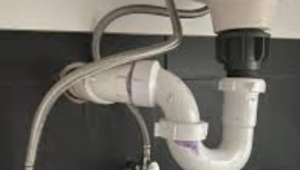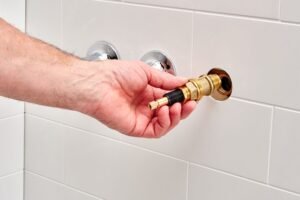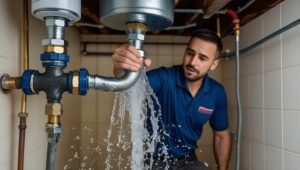When winter hits Cheyenne, Wyoming, the cold weather can bring serious challenges for homeowners, particularly when it comes to preventing frozen pipes. As temperatures drop, pipes exposed to the cold are at risk of freezing, which can lead to costly repairs and serious water damage. Let’s talk about how to prepare your home to avoid frozen pipes and how to protect your plumbing, whether you’re at home or away from home on vacation.
Key Steps for Preventing Frozen Pipes During Cold Weather
Frozen pipes are often caused by cold weather penetrating areas where pipes run, especially in unheated spaces like basements, attics, and exterior walls. When water inside the pipes freezes, it expands and can cause the pipes to burst, leading to water leaks and extensive damage. Fortunately, there are several steps you can take to prevent this from happening during Cheyenne’s brutal winter months.
1. Pipe Insulation
One of the most effective ways to protect your pipes is by using pipe insulation. This simple and inexpensive measure can significantly reduce the chances of your pipes freezing. Insulation helps maintain the temperature of the water inside the pipes and keeps the cold out. You can easily insulate exposed pipes in your attic, crawl space, or basement with foam sleeves or fiberglass wrap. It’s a must-do step when the weather begins to dip below freezing.
2. Keep Water Running
In the dead of winter, even a small flow of water can help keep your pipes from freezing. If you’re worried about certain pipes, keep water running through them at a slow trickle. While it might seem like a waste, the moving water is less likely to freeze. For pipes that are in danger of freezing, let faucets connected to them drip overnight. It’s a simple step that can save you from major damage.
3. Maintain Heat in Your Home
Whether you’re home or away from home for the holidays, it’s essential to maintain heat in your home. Even if you’re leaving for a few days, never set your thermostat below 55°F. When the temperature inside your home drops, pipes in the walls, particularly those on exterior sides of the house, are more likely to freeze. Keeping a consistent, moderate temperature can prevent this from happening.
4. Open Cabinet Doors
When temperatures dip, pipes under sinks—especially those on exterior walls—are vulnerable. A helpful tip is to open cabinet doors in the kitchen and bathrooms to allow warm air to circulate around the pipes. This is especially important if you’re away from home for an extended period. Allowing warm air to reach pipes can make all the difference in preventing freezing.
5. Seal Leaks and Drafts
It’s also critical to seal leaks and any gaps in the walls where cold air might be entering. Check areas around windows, doors, and pipes that lead outside. These small cracks can let in the cold and create the perfect conditions for pipes to freeze. Sealing these gaps will not only protect your pipes but will also help with heating efficiency.
6. Drain Pipes
If you’re going on vacation or plan to be away from home for a while, it’s a good idea to drain pipes to prevent freezing. Turn off the water supply to outside faucets and open the valve to let the remaining water drain out. Additionally, if you have hoses attached to any outdoor faucets, disconnect them. Even though this step requires a bit more effort, it’s well worth it to avoid dealing with a burst pipe upon your return.
7. Install Heating Tape
Another highly effective way to prevent frozen pipes is by using heating tape. This tape works by applying electrical heat directly to the pipes, keeping them warm and preventing freezing, especially in areas like attics or crawl spaces. If you’re worried about certain pipes freezing during the winter months, installing heating tape could be a solid investment.
8. Thermostat Settings
Ensure that your thermostat settings are consistent, particularly if you’re heading out for vacation. Many people think they can save money by turning the heat down significantly when they leave. However, this can create a huge risk of frozen pipes. If your thermostat fluctuates too much, pipes can freeze, causing significant damage. Keeping the heat at a steady level will keep your pipes from becoming a frozen disaster.
9. Winterize Pipes
Finally, winterize pipes in vulnerable areas. If you’re storing outdoor equipment or have any irrigation systems, make sure those are fully drained and turned off before the cold weather sets in. Winterizing pipes is a proactive approach to ensuring that your plumbing is well-protected throughout the harsh winter months.
FAQs
What should I do if I’m going on vacation during winter?
When away from home, make sure your home is heated to at least 55°F, and consider turning off the water supply to non-essential areas. Drain any outdoor pipes and disconnect hoses to avoid freezing.
Can pipe insulation be used on any type of pipe?
Yes, pipe insulation works on most types of plumbing, including copper and PVC pipes. It’s an easy and cost-effective way to protect your pipes.
What are the best ways to prevent frozen pipes in an unheated basement?
For unheated basements, it’s important to insulate your pipes, maintain heat in the home, and consider installing heating tape to keep pipes from freezing.
By taking these simple precautions, you can avoid the hassle and expense of dealing with frozen pipes. If you have any questions or need help preparing your home for winter, feel free to reach out to Forever West Plumbing. We’re here to ensure your pipes stay safe throughout Cheyenne’s cold weather!






